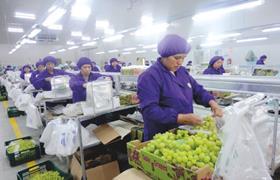
How would you sum up the 2015/16 grape season for Chapi?
Rafael Martín: Our best market for seedless grapes was undoubtedly the US, where we saw high prices and there was good demand across all categories. Prices for Red Globes weren’t so high, although the absence of fruit from other sources between December and May helped Peru.
In terms of Europe, we no longer see this as an interesting market for our seedless production from Ica as we have to compete with cheaper grapes from South Africa and Namibia.
In China I would say we had a better season than in 2014/15 for Red Globe after Chinese New Year, with high quality fruit arriving in good condition achieving reasonable returns. The lower availability of Chilean cherries on the market definitely helped prices, which ranged from US$10 per carton (8.2kg) to US$22.
Last year Agrícola Chapi became one of two new licensees for Sun World International in Peru. How has this boosted your grape profile?
RM: Being able to count on Sun World’s new seedless varieties means we can expand our export markets, while also giving us a more attractive and varied offer. We are interested in any variety that confers some kind of added value, whether it is a hardy seedless grape able to withstand longer journey times or a variety with an earlier or later production season that enables us to extend our sales window.
Can you tell me about the 1,000ha of land forming part of the Olmos Irrigation Project that you recently acquired in northern Peru?
RM: We have already planted the first phase of the project – some 500ha – and this is due to enter commercial production in 2017. About half of it is being planted with asparagus while the other half is made up of table grapes and avocados. However, the vast majority of our production (90 per cent) continues to come from Ica.
How is the 2016 avocado season shaping up? To what extent has El Niño affected production?
RM: Peru is set to produce a similar sized crop to last year. El Niño hasn’t had so much of an impact in terms of overall volume but it will probably mean that sizes will be somewhat smaller. We’re confident that there will be sufficient volume to supply all of our international markets, and see good potential to increase shipments to China and supply new markets in Europe.
What has your experience been in the Chinese market since it opened for Peruvian avocados in 2015?
RM: Agrícola Chapi starting exporting Hass to China last year and we were happy with the results of these initial shipments. As more and more consumers learn how to eat avocados, the market will continue to grow and we see excellent potential there, provided this growth in managed in an orderly way and we supply only the highest quality fruit.
Peru has made no secret of its aim to double fruit and vegetable exports by 2020. Is it on course to achieve this objective? What are the biggest challenges the country faces going forward?
RM: In Ica the main issue facing producers is the water shortage as there is still new land up for grabs. As an industry, it is important that we grow in an orderly manner, ensuring that supply is in line with international demand and that we avoid flooding the market and continue to add value to our products.



